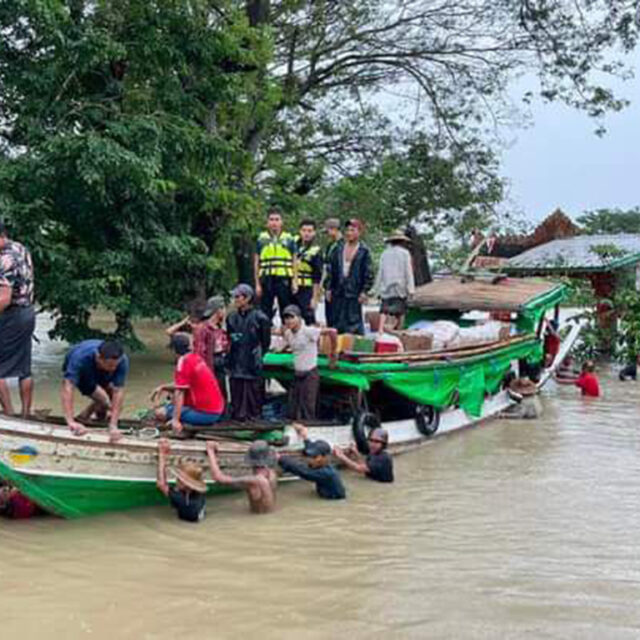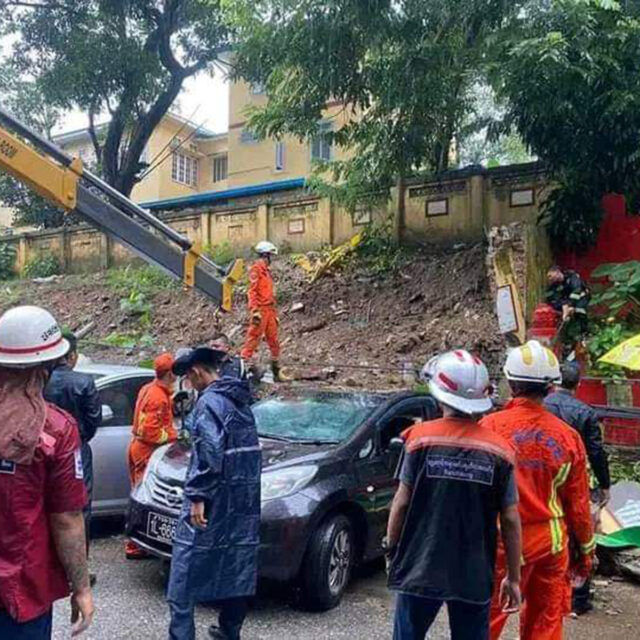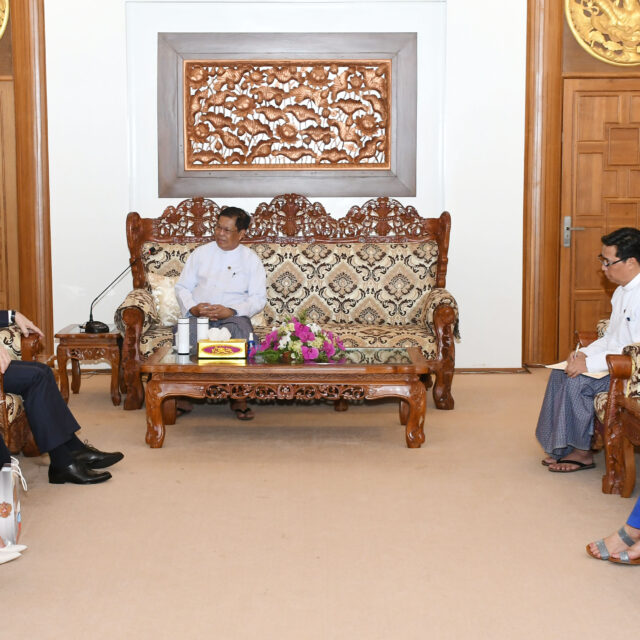By THAN HTUN (GEOSCIENCE MYANMAR)
EPISODE:19
E J Jones
E J Jones of the Geological Survey of India visited various localities to investigate coal, lignite, and other mineral deposits in Burma in 1887. He contributed “Notes on Burma” in the Record of Geological Survey of India, volume XX in 1887, Notes on Kashmir earthquake of 30 May 1885 in volume XVIII, Report on the Kashmir earthquake of 30 May 1885 in volume XVIII, Examination of nodular stones obtained by trawling off Colombo in volume XXI and Note on a cobaltiferous matt from Nepal in volume XXII.
Due to limited space, I can extract the following significant accounts from Jones’s comprehensive report ‘Notes on Upper Burma’ in the Record of Geological Survey of India in 1887.
THE CHINDWIN VALLEY
The strata exhibited in the Chindwin River at Monywa, the lowest point that I visited, consist of recent sand, resting on a ferruginous conglomerate containing fragments of the well-known fossil wood so widely distributed in Burma. I found this fossil wood at almost the highest point to which I travelled on the Chindwin (the neighbourhood of the mouth of the Kalé creek), and as far east as a short distance from the base of the Shan Hills; while according to Mr Theobald it is of very wide-spread occurrence in Lower Burma. At Alon, five miles up the river above Monywa, the same conglomerate is seen dipping slightly towards the east.
Tertiary
Above Alone the banks are low and sandy for some distance, but a few miles above the station, a ridge of sandstone, which, from the launch in which I was travelling, appeared horizontal, but which probably dips, as do the strata everywhere in this part of the country, to the east, is seen running across the river from east to west and forming a low cliff on each bank. Above this point, the right bank becomes less sandy and higher, while the left bank remains low and chiefly composed of sand. Another ridge of sandstone runs across just by Yathit.
Above Kani, the banks gradually become low again till, at about 17 miles below Maukdau, the river passes through a much higher range of sandstone hills. Above Mingin soft sandstones are seen on the right bank dipping to the east under the river; the left bank is fairly flat with an occasional small outcrop of the sandstone.
Cretaceous
At the junction of the Kalé creek (or Myit-tha) a fine-grained greenish yellow sandstone, harder at and near the weathered surface than inside and containing courses of a harder sandstone, is exposed dipping to E.15°S. at 30°. The harder courses are due to infiltrated silica and ferruginous matter. This sandstone also contains in parts ferruginous nodules and bands of a somewhat coarser texture.
The presence of the volcanic rocks is, however, interesting as it forms a further link in the volcanic chain running north through Narkondam and the extinct volcano of Popadaung, visited many years ago by Mr W T Blanford who pointed out that Popa was the continuation to the north of the great eastern line of volcanic outbursts running through the Eastern Archipelago.
The Kalé Coal-field
This is only a small portion of what promises to be a much larger field. It owes its name to the fact that some coal has been found and worked to some extent in the so-called Kalé creek (the Myit-tha), which flows into the Chindwin at the village known as Kalewa (Lat. 23° 4’N., Long. 94° 25’E.), situated on the right bank of the Chindwin between Mingin and Kindat.
Other coal seams on the Chindwin: I was informed by those who had the opportunity of observing the neighbouring country that this is by no means the only tributary of the Chindwin in which coal occurs, but that it is to be found in almost, if not quite, all the streams flowing in on the right bank below the Kalé creek, and to the north of this point as far as Tamu. Coal was also reported by Captain Stevens through the Political Agent, Manipur, in 1886 to occur in large quantities in the Kubo valley, though Captain Stevens did not think it would ever be able to compete with the Kalé coal. The only coal locality I visited was that on the Kalé creek. The coal is here found out-cropping on the right bank of the stream about 2.5 to 3 miles above its junction with the main river, and just below the village of Thitcho on the left bank, and Chau-oung on the right bank. About a ¼ mile below Chau-oung a small stream runs into the creek from the south, immediately below which the main seam of coal is exposed. The whole section included 16 kinds of strata which are mainly sandstone, clay, shales, and coal with a total thickness of 197 feet. (In 1970, my fourth-year geology field trip was to Kalawa Thitchauk coal mine and surrounding areas supervised by lecturer Dr Win Swe. It is still green in my memory.)
Quality and age of the coal: The coal appears to be of a fair quality, the great drawback being its friable nature. It contains the numerous small veins and pockets of fossil resin noticed in some of the cretaceous coals of Assam, and the Lenya River coal of Tenasserim, which is a good sign as Cretaceous coal is more likely to extend to a distance than the uncertain seams of Tertiary age.
Position of the mine: In the borings, it must be remembered that, owing to the high dip of the seam, the coal will appear to be thicker than it really is. Should they give equally favourable results on both sides of the river, I should recommend the mining, at any rate at starting, to be carried on on the left bank, as the ground is there much flatter, with a small plain between the river and the hills, whereas on the right bank, the hills come right down to the river. These preliminary trials should be put down by the government in order to see whether the coal extends to any distance.
Monywa Copper Mine: Opposite Monywa, at a distance of about three miles to the west of the river, there is a hill formed of petrosiliceous volcanic rocks. On this hill, which is known as the Letpadaung Taung, there are the remains of a copper mine, which was formerly worked by Oo Chaung, the younger brother of the Kinwoon Mingyi. Whether he ever obtained any large quantity of copper I was unable to find out, but I should think it very unlikely that the output was at all considerable, as the only traces of copper now extant consist of a few stains of green carbonate. The presence of the volcanic rocks is, however, interesting as it forms a further link in the volcanic chain running north through Narkondam and the extinct volcano of Popadaung, visited many years ago by Mr W T Blanford who pointed out that Popa was the continuation to the north of the great eastern line of volcanic outbursts running through the Eastern Archipelago.
THE PANLAUNG COALFIELD
The Panlaung River takes its rise near Singulébyin and flows northwards by a tortuous course till it eventually joins the Myitngé River, just before its junction with the Irrawaddy near Ava. The Panlaung coal field is situated on the right bank of the river, near its junction with the Myittha (which flows past Pyinyaung, the first post out of Hlaingdet, on the Shan Hill road). On the map of Upper Burma (1 inch = 16 miles), second edition, published by the Surveyor-General of India, the coal region is not marked as such, but it is situated in the neighbourhood of the spot marked Taungnga village (Lat. 21° 3’N., Long. 96° 24’E.), nearly opposite the village of Pachaung (or Petkyaung).
The coal is exposed in the beds of the streams running into the Panlaung on the right bank and in the hillsides to the east of the river. I was only able to visit the more accessible 11 groups of outcrops. The comprehensive report about 18 chief outcrops of coal has been mentioned in the report.
TWO COAL LOCALITIES IN THE SHAN HILLS
Légaung near Singulébyin: I was informed of the occurrence of this coal by the Lonpan Thugyi, who accompanied me from Singu to the place where the coal is to be seen. Légaung is a small village, about four miles from Singu in a southerly direction. Close to the village of Légaung, on the road to Kyat Sakan, coal is seen in two places. I was able to make out the following sections: surface soil, coal smut, Brown clay, coal smut, Brown clay, coal smut, white clay, powdery coal, and white clay.
Ngu, near Pwehla: This coal was brought to my notice by Maung Sein Bon on my return from Fort Stedman, and is situated about 7 to 9 miles north-west of Pwehla on a hill lying about a quarter of a mile from the village of Ngu. The coal is found in three places on the hill. In the first, it is 11 feet thick and dips to west 70°; it rests on clayey shale, contains a great deal of clayey matter and is very soft.
ON LIGNITE OCCURRING AT THIGYIT, NEAR NYAUNGWE
Having been informed that coal was reported by Mr Scott to exist at Thigyit, near Fort Stedman, and the coal of the Panlaung field not proving so good as was expected, I determined to take the opportunity of being in the neighbourhood to visit the locality. After much delay, I left Fort Stedam accompanied by the Myook of Thygyit. Thigyit is situated about 11 to 12 miles west of Indeinmyo, at the south end of the Nyaungywe Lake. The rocks are of the usual character, exposed in this part of the country, namely, massive limestones with red and pink shaly clays and conglomerates.
THE METALLIFEROUS MINES IN THE SHAN HILLS
Silver-lead Mines of Kyautat and Bawzain: Bawzain is a small village in the neighbourhood of Kyauktat, near Pwehla. About 1.5 miles to the north-east of the village there is a valley among the hills, the bottom of which is filled with red clay, the rocks of the surrounding hills consisting of limestone. In clefts in the limestone and below the red clay, a yellow, somewhat calcareous clay, occurs containing the argentiferous galena. The ore is said to occur in blocks and fragments, varying in size from three feet across to the size of a pea. I was unable to enter the mines, most of them having been closed for three years, owing to the disturbances in the country; and of the two that had been recently worked, one had been recently abandoned on account of its unsafe condition, while the other, being only worked during the dry weather, had been closed for the rains.
The large lumps, which are of too great a size to be readily carried out of the mine, are broken up and brought out with the smaller lumps and the clay in which they occur, and the whole is washed by means of water, which, while removing the clay, leaves the heavier fragments of ore behind. The ore is then collected in baskets and removed to one of the smelting houses in the neighbourhood. The ore is said always to occur in his manner, embedded in the yellow clay; and when it occurs in a cleft or fissure of the rock the walls of the cavity are frequently lined with crystalline calcite.
Where the ore occurs below the red clay in the bottom of the valley, square shafts, inclined at about 70°, are dug through the red clay, steps being cut till the yellow clay is reached, which is said to be at a depth varying from 50 to 150 cubits. Chambers, as large as the fear of subsidence of the roof will allow, are then excavated in the ore-bearing clay which is removed and carried to the surface.
Two baskets full of the ore are smelted at a time, the first operation being carried out in a small blast furnace heated with a charcoal fire. The lumps of ore without previous calcination are put into the furnace with charcoal, and ore and charcoal are added from time to time; and the molten lead drops down into a hollow below, from which it is ladled out into moulds. A large proportion of lead remains in the dark-coloured glassy slag, that is produced, while the only use that is made of the slag is as glass for the manufacture of ornaments. The silver is not refined any more, but sold in buttons, the price being, according to my informant, 8 annas per tola of rough silver.
Galena at Bwélon: Bwélon is a village about four miles from Bawzain in the direction of Kyauktat. The argentiferous galena occurs here in the same manner as at Bawzain, in yellow clay in fissures of the limestone rocks. The ore here is, however, richer in silver than that of Bawzain; it is said to give eight tolas of silver to two baskets of ore.
Argentiferous galena at Dwinzu: Dwinzu is about halfway from Bwélon to Kyauktat. The ore occurs here in the riverbed in the form of pebbles and in a fissure close to the stream. It is said to give 25 to 30 tolas of silver to two baskets of ore but is not so plentiful as at the other two localities.
References: Jones, E J, 1887: Notes on Upper Burma, Geological Survey of India, Vol. XX, Part 4.














